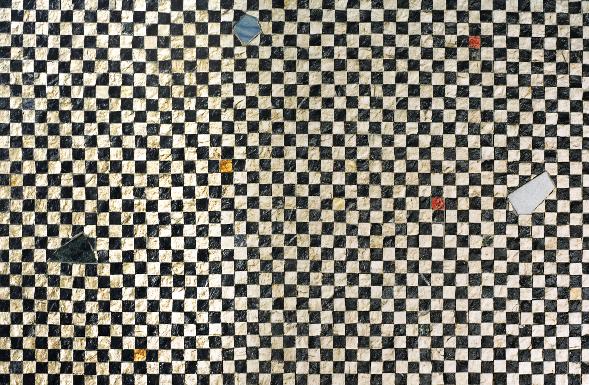

Field Mosaic - 5530A
Two tone chequerboard mosaic with re-salvaged rare marble fragmenti
Simple and eye catching design showing ancient marble fragments floating over a textured chequerboard mosaic bed
Each stone is carefully selected, cut and then assembled by hand. The slight indentations in the mosaic field, enhance the beauty of this mosaic despite its simplicity. Of particular interest is the irregular nature of the small tesserae, they contra flow with the randomly placed fragments, allowing the eye to rest and refocus. Only the discerning eye would pick this up, a small detail with maximum impact.
As is the case with all the De Ferranti Mosaic collections, we are able to fully customise the materials, colours and tailor the mosaics to your space creating unique and personalised pieces.
Product Specifications:
Bespoke: Yes
Finishes: Antiqued, Custom, Hand Finished, Handcut, Handmade, Honed, Interlocking, Matte, Patinated, Polished, Pre-sealed, Pre-waxed, Seamless
More about Stone & Marble Mosaics:
Very few artistic mediums are as expressive as that depicted by a handmade mosaic
The earliest known examples of mosaics made of different materials were found at a temple building in Mesopotamia, and are dated to the second half of 3rd millennium BC. They consist of pieces of coloured marbles and stones, shells and ivory. However, mosaic patterns were not used until the times of Sassanid Empire and Roman influence. In the 4th BC the colour range was extended by green and red pebbles.
In the ancient world mosaics were basically used for floors and footpaths. Longevity was an important reason for using mosaics. Tesserae made of marble and limestone were particularly suitable for making mosaics especially due to the vast ranges of colours available.
Although the origin of mosaics is accredited to the Greeks, mosaics were also used in Assyria, Egypt, Persia and other ancient civilisations. Roman mosaics enjoyed a good reputation, many designs are still en vogue today. The Romans sophisticated mosaics for the use onto walls and floors in halls, villas and public houses. After the roman era mosaics were integrated in Christian, Byzantine, Persian and Indian architecture.
De Ferranti has its own mosaic workshop near Venice and is proud to be continually breathing life into what could be soon a lost art.
People who viewed this product also looked at:

Appoggi Green and White Handpainted Terracotta Tile
Hand-painted in an artisan’s studio in Southern Italy more..

Inspired by the walls of Babylon, these ultra-luxurious wall bricks are faced with handcrafted and textured metal more..

Hammered Brass Briquettes - Texture I
Looking like part of an ancient temple, these astonishing Brass Briquettes are from De Ferranti’s 'Alchemy' Collection. more..

Hammered Brass Briquettes - Texture II
Looking like part of an ancient temple, these astonishing Brass Briquettes are from De Ferranti’s 'Alchemy' Collection. more..
By Appointment
DE FERRANTI
South Park Studios - Suite 10
88 Peterborough Road, London SW6 3HH
United Kingdom













